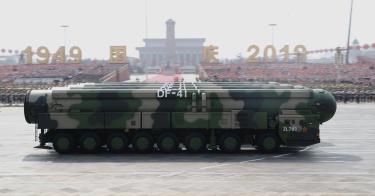During the Cold War, our nuclear arsenal served as the ultimate guarantor of American freedom and prosperity. Today, that arsenal is aged; the newest warhead is over 30 years old. Many are decades older.
The United States is now in the 13th year of a nuclear modernization program designed to update and modernize America’s strategic deterrent. During those 13 years, the number of new nuclear warheads the United States has built is zero.
In the last 12 months, China built 100 nuclear warheads. And it shows no signs of slowing down.
This October, a bipartisan group of experts, which included a former vice chairman of the Joint Chiefs, a former senator, a former undersecretary of Energy, the most senior living arms control ambassador in the United States, former officials from the National Security Council, and prominent think tank fellows, published a congressionally mandated report on America’s strategic deterrent.
>>> Beijing’s Hypocrisy Hits New High With Missile Defenses
Citing the breathtaking expansion of the Chinese nuclear arsenal—which, according to the Department of Defense, has doubled over the last three years—and the Russian nuclear arsenal—whose active stockpile of nuclear weapons is double the size of the American active stockpile—the Strategic Posture Commission warned of a “deterrence gap.”
The commission recommended several actions, including strengthening American conventional forces by building more ships, planes, and conventional missiles. But it also advocated an investment in our entire nuclear enterprise—the industrial base that supports designing, building, and maintaining our nuclear weapons and the bombers, missiles, and submarines that deliver them.
This investment is sorely needed. As noted, the United States is in year 13 of a nuclear modernization program. Unfortunately, it has little to show for it. A 2023 Government Accountability Office report on our ability to produce the fissile material necessary for nuclear weapons noted that the Department of Energy is years behind schedule and billions over budget. More worryingly, the report said that the modernization process would likely fall even further behind, and costs would further spiral.
Some life extensions on existing warheads have taken place, but such operations simply replace existing, decades-old wiring with new wiring.
Too many of today’s nuclear weapons rely on technology developed before most Americans were born. No one would expect a car built in 1967—but never driven—to start on the first turn of the key, but that is what we expect of our strategic deterrent.
Moreover, we should remember that the current nuclear modernization program began in 2010—when the world was far more benign. That world was one in which the United States hoped to work with China and Russia to combat terrorism, cooperate on environmental challenges, and cooperatively reduce the salience and size of global nuclear stockpiles.
That world, as we know, never materialized. As the current modernization program is designed for the benign security environment of the 2010s, it is necessary but wholly insufficient for a world where Russia regularly threatens to use nuclear weapons on its neighbors, where China seeks to become the regional hegemon, and where the United States’ ability to deter the threats of the 2030s may be increasingly questioned by determined adversaries—particularly those building and fielding theater-range, low-yield nuclear weapons designed to target U.S. bases across the Western Pacific and Europe.
>>> 40 Years After Reagan, Neglected U.S. Missile Defense Is Dangerously Obsolete
A credible strategic deterrent is the cornerstone of America’s national security and is the primary mission of the Departments of Defense and Energy. To meet the growing threat, we must develop and field new systems, such as the nuclear-armed sea-launched cruise missile, and begin to think more comprehensively about what an effective strategic posture in the 2030s should be.
Before leaving for the year, Congress voted on the bill to fund the Department of Defense in 2024. This bill takes important steps to strengthen America’s deterrent—to include fully funding the modernization of our nuclear triad, establishing the nuclear sea-launched cruise missile as an official program of record, and accelerating the deployment of advanced sensors and defenses to counter long-range, high-altitude threats to our homeland from our adversaries in Beijing and Moscow.
But more is needed.
To build out the capacity necessary to scale our nuclear enterprise, we must grow every part of the workforce. Tens of thousands of Americans, from those with eight-week training certifications to become apprentice welders to Ph.D. physicists and engineers and everything in between, will be needed to build the deterrent necessary for America’s security.
It also requires significant and sustained financial commitments to address the problems that plague our ability to produce new nuclear weapons. It requires sustained, bipartisan political support from the Oval Office to Capitol Hill to the American people. It will require determination and urgency on the part of the nuclear enterprise to revitalize the industrial base to produce the warheads, bombers, intercontinental ballistic missiles, and submarines. But it can be done.
We must move with purpose—and soon.
This piece originally appeared in the Washington Examiner



